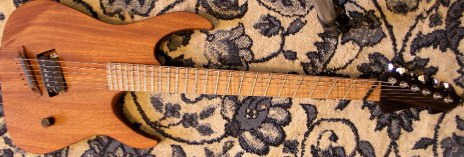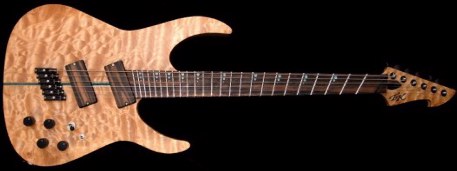The Fifth Dimension
Fifths Tuned Hybrid Instruments
 |
Some examples of fifths tuned guitar:
A little history on my reasons for converting to Fifths
|
|||||||
Being one of those musician/luthiers that is ALWAYS searching for something new and inspiring; I decided many years ago (early 1990) to go from an already not so standard guitar tuning of all 4th's [E-A-D-G-C-F] to a more radical tuning of all fifths...
One of my main reasons for converting to fifths was mostly due to just being bored with myself as a guitarist.
It pretty much came to me one late night in early 1990' when I saw a 5 string electric violin being played.
There was just something about seeing and hearing this instrument that just completely floored me!
I mean the unusually thick tone of the instrument, the fact that it had no frets, and was bowed rather then picked...
Basically I was "hooked".
This was just so inspiring to me, that I had to design/build an electric bowed instrument that could have the same range of a 5 string electric violin, but was tuned in fourths like a guitar, yet could be played in more of an ergonomic upright "cello on the knee" type of position.
Well after many prototypes had been built, I eventually came up with an instrument that I now call the Vicellotar.
[The instrument later went on to become a semi acoustic hollow Vicellotar, and eventually mutated in to the latest (and my personal favorite!) version called the Vicellotar 'V'.]
As I studied the violin masters, I soon began to realize that because violin phrases were originally created in fifths; they should be executed in fifths in order to get the same results violinist's were getting (obviously!).
So with sheer passion being my driving force; I decided to re-tune my new Vicellotar to fifths!
Now here is where Fifths tuned guitar comes in:
So in order to get used to my newly re-tuned to fifths Vicellotar; I figured that I should probably re-tune my guitar to all fifths as well...
I mean after all, my hands already knew the guitar rather well, so I figured if I could just use the guitar neck to help me learn fifths tuned scales, chords, etc., then I could more easily transpose this knowledge back onto the rather difficult to play Vicellotar.
Well almost immediately, I fell in love with fifths tuning for guitar!
(Thus ending my personal dry spell towards my guitar playing)...
|
|||||||
On a side note:
|
|||||||
Since tuning in fifths back in 1990, I have never had the desire to return to standard tuning.
I now tune all my instruments in this way; even the really strange ones, like my Ztar!
This tuning has opened doors to new music that has constantly amazed and surprised me.
I am always melodically satisfied and I am always inspired.
My guitars only have 6 strings yet they exceed the range of a 7 string guitar!... (6 octaves to be exact)
Also: once you start to study the early virtuoso (romantic period) violinists and cellists, you soon realize that they were doing things 200 years ago with fifths tuning that even the best of today's virtuoso guitarists are just beginning to scratch the surface of...
I should also note that for me the change to fifths was VERY rapid.
In fact; within just a few weeks of tuning my guitar in this way, I had sent out a solo tape for Guitar Player Magazine's annual "Readers Sound Page Competition" and I actually placed!
You can read a little bit about it in the August 1990 issue of Guitar Player Magazine, they were even cool enough to mention the fact that I was tuned in fifths!
I guess the whole point I'm trying to make here is; if I can do this, then so can you!
Now please don't get the idea that I'm trying to say fifths is some how better then standard guitar tuning, I'm just saying it was definitely better (and VERY refreshing) for me... So perhaps it might even be better for you too?
|
|||||||
|
|||||||
Okay, now back to the main purpose for this page:
|
|||||||
Well after over many years of trial and error, this rough prototype instrument (seen in the upper left photo) was the beginning to my latest answer for the perfect hybrid guitar... Where as the instrument seen just below the prototype is the first official TK Instruments Signature Series Hybrid Guitar.
What is meant by "Hybrid"?
In standard (e.a.d.g.b.e.) tuning the longer scale length on the low E string is much like a piano string: rich and full of harmonics, where as the high E string is set at just the right tension to pitch ratio.
However, if you are a guitarist that is into dropped and/or alternate tuning's, then the longer scaled bass side of the multi scaled neck is also perfect for this.
And this is where the fifths tuning really shines!
For example:
Tuning all 6 strings in fifths using a ,074" at a low 'G' on a standard 25.5" scaled guitar (as described above) works okay for just experimenting in fifths, but the main problem with this was that the low 'G' was always a pretty floppy string.
In reality, a proper tensioned fifths tuned guitar should actually have a longer scale length on the lowest string or "bass side" of the fingerboard.
Because the low 'G' ( 2 steps below a low B on a 7 string Guitar) is really just too floppy for a standard 25.5" scale guitar, it really becomes impractical to tune any standard 25.5" or even 24.75" scaled guitar to 'G' based fifths.
So, my solution for an instrument with a more balanced tensioned tuned in all fifths, was to just lengthen the neck's bass side scale length up to 27" while keeping it's treble side scale length to at least 25" (This is how I built the prototype instrument seen in the photo above).
In reality I could have even gone up to 28" on the bass side, but the fret and bridge angles would just be far too extreme for any real use.
{Although, perhaps a baritone 29"x27" Fifths guitar, tuned:(F-C-G-D-A-E) might be pretty cool as well?!?! Please let me know what you think of this idea}
The above instrument design seems to address these issues of "tension vs. pitch" (in both standard as well as all Fifths) yet still maintains excellent ergonomic playability.
So the main reasons I am calling these instruments "Signature Hybrid" are as follows:
"Signature" because they are my personal favorite design, so I guess you could say that I'm extra proud to put my "TK" initials on the headstock.
"Hybrid" because they are designed to run on multiple tuning's (mainly standard guitar 4ths along with the commonly used dropped 'D' tuning and of course my favorite; all Fifths).
I should also mention that:
fifths can be a very cool thing for bassist's too!
I have used fifths tuning on my 5 string bass for many years now, so you can be sure that I will continue building the 5 string multi scaled basses that also set up excellently in all Fifths, either in C (above a low B) or, even low 'A' (below a low 'B' ).
Of course keep in mind that, just like the Hybrid Guitar; the Basses are also easily reversible to standard tuning.
After all, I am aware that I probably wont convince the entire world of guitar and bass players into re-tuning their instruments to fifths; nor do I plan on selling instruments as ONLY set up in fifths...
For that matter, I am more then happy just building/selling these as standard tuned instruments, so that I can occasionally snag one for myself and re-tune it to Fifths!
After all, that's ultimately why I build instruments in the first place... It certainly isn't for the money!
However: if there are a few of you who read this , and then decide to try out the fifths tuning on your own, only to find out that you too have become addicted;
then I would be more then honored to offer you a handcrafted Signature Hybrid series guitar and/or bass, set up in all fifths.
These instruments (in any tuning) will of course be built incorporating all of the current styles and options listed within this site...
The guitars will most likely feature special humbucker pickups that are designed to sit at an angle that corresponds with either the bridge angle or highest fret angle.
I have already worked on a few prototype guitar pickups (as seen in the photo above), and so far it seems that most standard pickups can be slightly modified to be mounted to the correct angle.
The Guitars will often feature *25 stainless 5/32" frets, but on occasion (If I get a lot of requests for this), I might build a few of them with 24 standard sized frets.
*{The main reason for 25 frets is because when tuned in fifths, you need the 25th fret to make the instrument a full 5 octave range.}
|
|||||||
One other thing I wanted to mention:
I am aware of some guitarists tuning in partial fifths (Robert Fripp's "Guitar Craft" ) and that there are/were even a few five string 5th tuned guitars; but I'm not aware of any -6- string guitars that were ever tuned to fifths on ALL 6 strings.
Please let me know if you have ever heard of, or have any documentation of anyone else doing of this prior to 1990.
|
|||||||
Because fifths is such a passionate subject to me:
|



